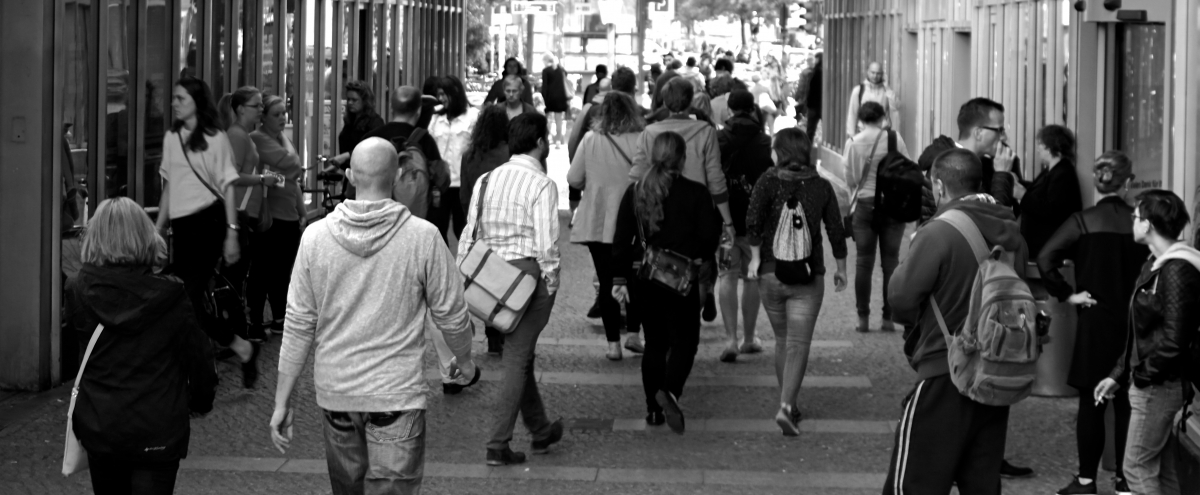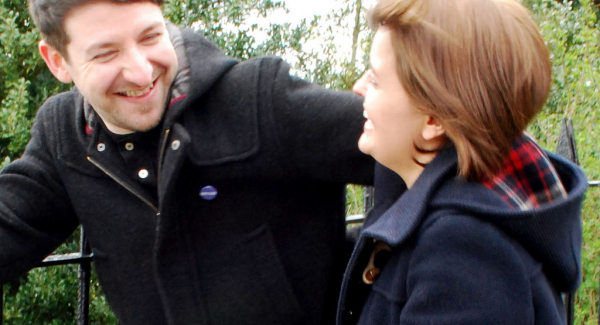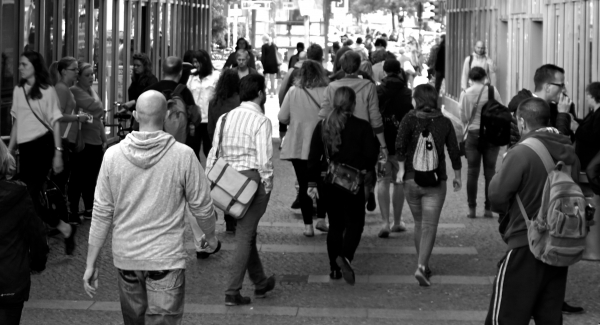
People are not likely to help when faced with an emergency. Are they all heartless or is something else going on? Science reveals that we can explain this lack of helping behavior by the Bystander effect and that there are ways to decrease this effect.
It was a busy Monday night in Café Moto in Williamsburg, Brooklyn. Cars were passing by and more guests entered the restaurant. The restaurant seats 35 people, but it was more crowded than that. The guests were enjoying their dinner in the vintage style restaurant, and the lamb ribs, mussels, and fresh baked cake were particularly popular. Whenever a train passed by, the volume of conversations rose.
Then something remarkable happened, people heard a harsh sound through the whole restaurant. The waitress later declared that she heard something like a firecracker, but she was too busy serving food to stop and wonder where the sound came from. A man at the bar turned to a stranger beside him, the bass player. “That”, he said, “sounded like gunshots”. The bass player agreed. People knew something was wrong, but nobody in the restaurant responded; nobody screamed and nobody ran towards or away from the window facing the street. A man saw something out of the corner of his eye and looked in time to see a man hurrying past, clutching his leg. Ms. Dobson, who performs weekly in the restaurant, picked up her guitar and started playing again. She could not believe what she saw a few moments later; the streets were filled with ambulances, and lights were everywhere. Several groups of people stood in huddles watching the scene. The police cordoned off the area with yellow tape. Officers found two shell casings from a nine millimeter pistol.
It is obvious that no firecrackers were involved. A fight broke out in front of the bar and got out of hand in the middle of the crowd of passengers who had just arrived by train. One of the passengers was a ten-year-old boy; he became a victim for being in the wrong place at the wrong time. The people in the bar were right; something was wrong -very wrong. A boy was shot and nobody responded.
To most of us, it seems bizarre that none of the people present responded. But this is not an exceptional event, more situations are known where people were robbed, abused, and even murdered in the presence of others. Is it true that these bystanders have a lack of empathy or are they just jerks? Probably they are just people like you and me. Psychologists know that there is another reason for this kind of phenomenon: The bystander effect.
The Bystander Effect
The bystander effect refers to the fact that people are less likely to help in an emergency when more people are nearby. A classic study shows and explains this effect. Participants were asked to sit down in individual cubicles and could communicate with other subjects over an intercom system. There was actually only one real participant in the study; the other participants were prerecorded voices, including one person that had a seizure. The researchers manipulated the size of the discussion groups; some discussion groups consisted of only the participant and the ‘victim’, whereas others consisted of these two with a third person (the perceived bystander), or with four perceived bystanders (Darley and Latané, 1968).
After a few minutes of discussion, the real participant heard through the intercom that the other participant was having an epileptic seizure. Now the question is; will the real participant help by summoning the experimenter or will he or she simply sit and do nothing? In the non- bystander group most people (85%) helped, in the group with one bystander 62% helped, and in the group with four bystanders only a devastating 31% reported the emergency. Darley and Latané (1968) concluded from this experiment that an individual’s likelihood to help decreases when there are more people around. This could also be a reason for the fact that nobody helped in Café Moto. Yet, the questions remains, why does the number of bystanders influence the helping behavior of people?
Why We Do Not Help
People often think that the lack of helping behavior is caused by apathy or a general indifference towards the victim. Instead, non-helpers are in general more upset than helpers (Darley & Latané, 1968). A person who faces an emergency is in conflict; this is particularly true when it is a dangerous situation such as the shooting near the bar. People in general have rational and irrational fears about what might happen when they would intervene - maybe they will get hurt as well (Milgram & Hollander, 1964). On the other hand, most of us have innate humanitarian urges that make us want to help a victim. But what could weaken our tendency to help and be a good humanitarian? In the following section I will name three possibilities why we do not help when we face an emergency. If you are aware of these three constraints for being a good humanitarian, you might be better in overcoming these constraints when you will face an emergency situation in the future.
We do not notice an emergency.
The first one is as obvious as it is simple: You have to notice that someone needs help. When a person hurries down a crowded street, he or she will be less likely to notice someone who is in need. So something trivial, like being in a hurry, can make people less likely to help. A study showed this by dividing participants into two groups: a hurry group and a non-hurry group. As they were walking to another building, each of the students passed a man who was lying in the doorway. The man, an accomplice of the experimenters, coughed and groaned as each student walked by. The students who were not in a hurry provided help most of the time (63%). However, students who were hurrying to keep their appointment helped in only 10 % of the cases. This may be partially explained by the fact that many of the hurrying students failed to notice the ‘victim’ (Darley & Batson, 1973). The same may have happened with the waitress in Café Moto, who was too busy serving food to stop and wonder what was going on when she heard the gunshots.
We do not interpret it as an emergency.
Even if people do notice an emergency, they still may fail to act. It is also necessary to interpret the event as an emergency as people are not always certain about what is going on in a situation. For example, when you are in a bar and hear a strange sound, you might think that nothing is wrong when nobody else reacts. In this case, you use others as a source of information. The problem with using others as a source of information is that others may not be sure what is going on either. Since an emergency is often a sudden and confusing event, bystanders tend to freeze with blank expressions as they try to figure out what is going on. When they glance at others they see an apparent lack of concern on their faces as well. This is called pluralistic ignorance; bystanders assume that nothing is wrong in an emergency when no one else looks concerned (Aronson & Akert, 2007). This may have happened in Café Moto as there were no reactions after the gunshots and the people present did not interpret the event as an emergency.
We do not feel responsible
Although most of them are, not every emergency is ambiguous to the bystanders. There are emergencies in which people do know that something is wrong, like the two men in the bar who did perceive the sound as gunshots. However, they also did not help, perhaps because they might not have felt any responsibility to do so. We can explain this reluctance to help by considering diffusion of responsibility; each bystander’s sense of responsibility decreases as the number of witnesses’ increases. The responsibility is exclusively yours shoulders when alone, but becomes reduced when there are more people. It feels like the bystanders literally share the responsibility and therefore this diminishes the responsibility per person. Since the individual might perceive a low level of responsibility, he or she might not act in response as well (Aronson & Akert, 2007). When it is just you facing the emergency, you are the only person in a position to help the victim, and so most of us will not hesitate to help. When more people are around this certainty that the victim will go unassisted disappears. This is also what might have happened in the seizure experiment as well as in Café Moto: Every individual might have thought that some of the other bystanders already helped and because of this they do not feel responsible themselves.
How Can We Get People to Help?
Although people are less likely to help when more bystanders are present, people do help in some cases. For example, people are more likely to come to help when they have heard of the bystander effect before. Students who heard about the bystander effect in class were more likely to help compared to students who did not know about this effect (Beaman, Barnes, Klentz, and McQuirk, 1978). In the following section I will name three possible ways to reduce the bystander effect, which could help you if you are ever to find yourself a victim and need assistance.
When we know what is going on.
It would be wise to make the situation clear to the bystanders as a victim since the likelihood of helping also depends on whether the bystander understands what is happening. For example, people are more likely to help when they know that a strange man hits a woman than when he they think that he is her husband. This is because else people will rationalize that it is something private, and use that as an excuse to not help. People will assume that the offender is her husband more often and will not help consequently (Felson & Feld, 2009). Another example is the two boys who murdered James Bulger, a two and a half year old boy, with possible helpers present. The bystanders later declared that besides the fact that they did not know how serious it was, they did not intervene because they thought that these boys were brothers. The fact that they saw the three boys as members of the same family might have made them reluctant the help as an outsider (Levine, 1999). This is in line with another finding showing that people are more likely to help someone who they perceive as a group member than one from a different group (Levine, Prosser, Evans, 2005). But whatever exactly is the underlying reason with these examples, the victims might have been helped by a bystander when the situation would have been more clear to the bystanders. This could avoid potential rationalizations and consequently make people more likely to help.
When we are addressed personally.
Furthermore, it would be wise to address one of the bystanders personally when you need help. People are more likely to help when a victim addresses him or her personally (Shaffer, Rogel, & Hendrick, 1975). Another study aligns with this finding. Two fictional persons sought help by asking all participants in a chat group, “Can anyone tell me how to look at someone's profile?” or by randomly selecting one participant and addressing him or her with his or her name. When they addressed someone personally, it overrides the effect of the number of bystanders. While this study seems trivial, it is particularly important in showing that directly addressing people in bystander situations seems to get people to provide help. So when you are in a situation that requires immediate assistance, you may want to call for that one particular person with the blue shirt.
When we have ‘helper’ characteristics.
If you indeed find yourself in such a situation, which person is most likely to come to the rescue? Huston, Ruggiero, Conner, and Geis (1981) interviewed 32 people who helped in dangerous criminal episodes such as street muggings, armed robberies and bank holdups. They compared this group of ‘interveners’ with a group of ‘non-interveners’. Interveners reported that they saw more emergencies in their lives and experienced more situations in which they were the victim compared to the non-interveners. The most significant difference between the two groups was the amount of training they had that might have assisted their helping behavior (Huston et al., 1981). People who had training in first aid, life saving, medicines or police training were more likely to help in emergencies. This was also the case when the particular training was not applicable in the particular helping situation. For example, people who had life saving training were also more likely to help in non-health related emergencies. The researchers argued that the training reinforced the intervener’s self-image as a person who is able to help others. The interveners also had different physical characteristics compared to the non-interveners. The helpers were taller in inches and they were a few pounds heavier than the non- helpers. So according to this study, it is best to address the people with some training in helping behavior, and when you don’t have that information; your best pick is to address the tallest and heaviest person around (Huston et al., 1981).
To Conclude
We cannot just explain people’s reluctance to help through apathy or indifference. More people simply being present leads to less helping. Although the number of bystanders has a strong effect on helping behavior, it seems possible to override this when using the right interventions. Knowing these can be helpful when you will find yourself as a bystander and would like to be a good humanitarian, or if you will find yourself in such an emergency as a victim and need help yourself. I described three helpful interventions for both of these situations. First, we can be better helpers when we notice emergencies by being aware of what happens around us (Darley & Batson, 1973). Second, we can be better helpers when we don’t just assume that others reactions resemble the truth about what’s going on in an emergency situation (Aronson & Akert, 2007), Third, we can be better helpers when we tell ourselves that we are responsible to get to help even when others are around, thus negating diffusion of responsibility (Darley & Latané, 1968).
What might be even more important is how we can get others to override the bystander effect when we need help ourselves. First, we have a bigger chance to receive help when we would make the situation clear to the bystanders if possible (i.a. Felson & Feld, 2009). Second, we can get people to override the bystander effect when we address them individually so they will feel responsible (Shaffer et al., 1975; Markey, 2000). Third, we can increase our chance to receive help by addressing the tallest and heaviest person around (Huston et al., 1981).
So are we all jerks? Maybe we were but hopefully not after you read this article. There seems to be several ways to become a better humanitarian in an emergency and there are several ways to promote helping behavior among bystanders. The proposed actions to encourage people to help you as a victim seem simple, but if you know them well, they can save your life.
References
Aronson,E., & Akert, R.M. (2007). Social psychology. London: Pearson.
Beaman, A., Barnes, P. J., Klentz, B., & McQuirk, B. (1978). Increasing helping rates through information dissemination: Teaching pays. Personality and Social Psychology Bulletin, 4, 406–411.
Darley, J.M., & Batson, C.D. (1973). ‘From Jerusalem to Jericho': A study of situational and dispositional variables in helping behavior. Journal of Personality and Social Psychology, 1, 100-108.
Darley, J.M., & Latané, B. (1968). Bystander intervention in emergencies: Diffusion of responsibility. Journal of Personality and Social Psychology, 8, 377–383.
Felson, R. B., & Feld, S. L. (2009). When a man hits a woman: Moral evaluations and reporting violence to the police. Aggressive behavior, 35, 477-488.
Huston, T.L., Ruggiero, M., Conner, R., & Geis, G. (1981). Bystander intervention into crime: A study based on naturally-occurring episodes. Social Psychology Quarterly, 1, 14-23.
Latané, B., & Darley, J. M. (1970). The unresponsive bystander: Why doesn’t he help? New York: Appleton-Century-Croft.
Levine, M. (1999). Rethinking bystander nonintervention: Social categorization and the evidence of witnesses at the James Bulger murder trial. Human Relations, 52, 1133-1155.
Levine, M., Prosser, A., Evans, D., & Reicher, S. (2005). Identity and emergency intervention: How social group membership and inclusiveness of group boundaries shape helping behavior. Personality and Social Psychology Bulletin, 31, 443-453.
Markey, P.M. (2000). Bystander intervention in computer-mediated communication. Computers In Human Behavior, 2, 183-188.
Milgram, S., & Hollander, P. (1964). Murder they heard. Nation, 198, 602-604.
Shaffer, D.R., Rogel, M., & Hendrick, C. (1975). Intervention in the library: The effect of increased responsibility on bystanders’ willingness to prevent theft. Journal of applied Social Psychology, 5, 303–319


